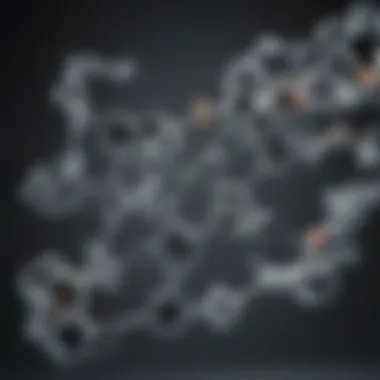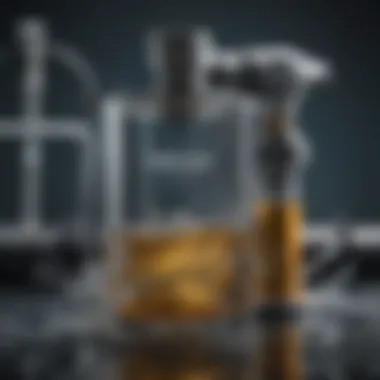Ferrate Water Treatment: Efficacy and Applications


Intro
Water treatment is a critical aspect of environmental science, directly impacting public health and sustainability. In this context, ferrate water treatment stands out as an innovative approach with promising potential. This method utilizes ferrate, a compound of iron, known for its strong oxidizing properties. By exploring this technology, we can assess its efficacy and applications in modern water purification.
Ferrate has gained attention for its dual role as both an oxidant and a coagulant. This makes it distinctive among conventional treatment methods. As we delve into this overview, we will highlight its chemical properties and mechanisms of action, providing a foundation for understanding its impact in the field of water treatment.
Understanding Ferrate
Ferrate, particularly ferrate (VI), is gaining attention in the field of water treatment due to its unique properties and capabilities. Understanding ferrate and its applications is crucial for recognizing its potential as a method for water purification. The increasing need for effective and environmentally friendly solutions to water treatment challenges emphasizes the importance of comprehending the fundamental aspects of this compound. Ferrate's stability, reactivity, and ability to form various oxidation states of iron make it a subject worth analysis in the broader context of water treatment technologies.
Chemical Composition of Ferrate
Ferrate consists primarily of iron and oxygen. Its most common form is potassium ferrate (K2FeO4). The high oxidation state of iron in ferrate contributes to its potent oxidative capabilities, which are utilized in breaking down pollutants in water. The unique ratio of elements gives ferrate its distinct chemical properties, setting it apart from traditional coagulants and oxidants used in water treatment.
Ferrate can also exist in different forms, including sodium ferrate and calcium ferrate. These variations can affect the solubility and behavior of the compound in aqueous solutions. Understanding its chemical composition helps in predicting its interaction with various contaminants.
Oxidation States of Iron
Iron can exist in multiple oxidation states, including +2 (ferrous) and +3 (ferric). In ferrate, iron is in the +6 oxidation state. This high oxidation state is critical for its function in water treatment. Ferrate acts as an electron acceptor, facilitating oxidative reactions that degrade organic and inorganic contaminants.
Monitoring the oxidation state is essential because it influences the effectiveness of ferrate in various environments. For example, in acidic conditions, ferrate can convert to less effective forms, thus reducing its oxidative capacity. Therefore, understanding the oxidation states of iron is essential for optimizing conditions for ferrate’s applications in water treatment.
Mechanism of Ferrate Water Treatment
Understanding the mechanism of ferrate water treatment is essential for comprehending how this innovative approach alleviates various water quality issues. Ferrate, primarily as ferrate(VI), acts as a potent oxidizing agent in water treatment processes. Its efficacy lies in its ability to engage in various oxidative reactions that degrade persistent contaminants, including organic compounds and microbial pathogens. The mechanism not only enhances treatment efficiency but also underscores ferrate's potential as a sustainable alternative to traditional methods.
Oxidative Reactions Involved
Oxidative reactions are at the core of ferrate water treatment. When ferrate is introduced into water, it undergoes reduction reactions, leading to the formation of ferrous ions and reactive oxygen species. These species are capable of breaking down organic pollutants and removing pathogens effectively. The ability of ferrate to oxidize pollutants arises from its unique electronic structure, allowing it to accept electrons from contaminants with relative ease.
Moreover, ferrate can react with various organic contaminants, including phenols, pesticides, and even some heavy metals. This broad-spectrum activity makes it especially valuable in treating complex wastewaters. Research indicates that the reaction rates of ferrate with different pollutants vary, depending largely on the chemical structure of the target compounds. Understanding these reactions can help tailor ferrate applications to specific treatment needs.
Formation of Reactive Species
The formation of reactive species is a critical aspect related to the mechanism of ferrate treatment. During its oxidative process, ferrate generates several reactive intermediates such as hydroxyl radicals. These radicals possess a high degree of reactivity, allowing them to attack and decompose a wide range of pollutants without the need for additional treatment agents.
The presence of these reactive species can significantly enhance the breakdown of complex molecules, increasing the overall efficacy of the treatment process. Studies have shown that hydroxyl radicals can degrade organic pollutants at rates several times higher than those for traditional oxidants. By optimizing conditions such as concentration and contact time, water treatment efficiency can be greatly improved.
Role of pH in Treatment Efficiency
pH plays a significant role in the overall effectiveness of ferrate water treatment. The stability of ferrate compounds can be influenced by the pH of the water. Optimal pH levels typically range from 7 to 10. If the pH drops below this range, ferrate may decompose into less effective compounds, such as ferrous ions, thus reducing its oxidizing potential.
Moreover, the reactivity of ferrate with various contaminants can also depend on pH. Certain pollutants may be more amenable to oxidation at specific pH levels. This means that maintaining the appropriate pH not only enhances ferrate stability but also ensures maximum contaminant removal. Monitoring and adjusting pH during treatment processes can therefore be a critical factor in achieving desired outcomes.
Understanding the fundamental mechanisms of ferrate water treatment can lead to more efficient applications and potential innovations in water purification technology.
Ultimately, a thorough grasp of the mechanism behind ferrate's action in water treatment can inform best practices and strategies for implementing this technology more widely.
Advantages of Ferrate Treatment
Understanding the advantages of ferrate treatment is crucial for evaluating its potential role in water purification. This section will examine the key benefits that ferrate treatment offers, which include environmental benefits, effectiveness against microbial contaminants, and the broad range of contaminant removal capabilities. These advantages highlight why ferrate can be a powerful tool in modern water treatment practices.
Environmental Benefits


Ferrate treatment stands out for its environmentally friendly approach. One of the major environmental benefits of ferrate is its ability to decompose into non-toxic byproducts after its application. Unlike many traditional water treatment chemicals, ferrate does not produce hazardous residues. As a result, its use contributes to a reduction in pollution and helps safeguard ecosystems.
Furthermore, ferrate has the potential to lower the overall use of chlorine and other harsh chemicals in water treatment. Chlorination can lead to the formation of harmful byproducts that pose risks to human health and the environment. By utilizing ferrate, water treatment facilities can mitigate these risks while still achieving effective sterilization and disinfection of water sources.
Effectiveness Against Microbial Contaminants
A significant advantage of ferrate treatment is its strong effectiveness against microbial contaminants. It has been shown to be efficient against a variety of pathogens, including bacteria, viruses, and protozoa. Ferrate exhibits a high oxidizing strength which enables it to destroy the cell walls of these harmful organisms, effectively rendering them inactive. This property makes ferrate an attractive option for ensuring water safety and quality.
In addition, the application of ferrate can be implemented in various conditions, including different pH levels, which enhances its versatility in dealing with microbial contamination. Research indicates that ferrate maintains its efficacy even in challenging environments, making it a reliable choice for different water treatment scenarios.
Broad Range of Contaminant Removal
Ferrate treatment is not limited to microbial contaminants; it is capable of removing a broad range of pollutants from water sources. These include heavy metals, organic compounds, and other toxic substances that are often difficult to eliminate with conventional treatments. By facilitating powerful oxidation reactions, ferrate can convert many harmful substances into less toxic forms, effectively clearing them from the water.
Specifically, ferrate has been proven to reduce contaminant levels of substances such as arsenic and chromium, which are known for their detrimental effects on health and the environment. Additionally, ferrate can address contaminants associated with industrial waste, making it a valuable asset in the field of industrial wastewater treatment.
In summary, ferrate treatment offers numerous advantages, ranging from environmental benefits to effectiveness against a diverse array of contaminants. Its unique properties position it as a leading option for modern water treatment challenges.
The advantages of ferrate treatment present a strong case for its implementation as a method that not only addresses water quality issues but also prioritizes ecological safety. This knowledge is key when considering the future of water treatment technologies.
Limitations and Challenges
Understanding the limitations and challenges of ferrate water treatment is crucial for several reasons. Firstly, recognizing these aspects allows researchers and practitioners to evaluate the practical viability of this technology in real-world applications. While ferrate presents compelling advantages, potential obstacles must be acknowledged to ensure its effective and safe implementation.
Stability Issues of Ferrate Compounds
One of the primary concerns regarding ferrate treatment lies in the stability of ferrate compounds. Ferrate, particularly ferrate(VI), is known to be thermally unstable and can decompose if not handled properly. This instability can lead to reduced efficacy over time. Moreover, storage conditions often affect the longevity of ferrate compounds, which can limit their practicality in large-scale applications.
Studies indicate that the lifespan of ferrate can be significantly affected by environmental parameters such as temperature and pH levels. Therefore, researchers must explore methods to enhance the stability of ferrate formulations to make them more suitable for continuous water treatment processes.
Cost Considerations
Cost is another significant factor when evaluating ferrate as a water treatment method. Producing ferrate involves specific chemical processes that can be expensive. The initial investments required to implement ferrate treatment systems may deter water treatment facilities from adopting this method, especially in industries where budget constraints are prevalent.
Furthermore, ongoing operational costs, such as maintenance and monitoring of ferrate applications, must be accounted for. Consequently, detailed cost-benefit analyses are essential to determine whether the advantages of using ferrate outweigh these financial considerations.
Potential Side Reactions with Other Water Components
Ferrate's interactions with other components in water can also pose challenges. When ferrate is introduced into treated waters, it may engage in side reactions with organic matter, chlorides, and other substances. These reactions can hinder its effectiveness and generate undesired byproducts, potentially complicating the treatment process.
Understanding these interactions is necessary for optimizing the use of ferrate. Researchers must investigate how ferrate behaves in various water chemistries to avoid adverse outcomes. Conducting thorough studies on this topic is vital to ensure that ferrate treatment can be efficiently integrated with existing water treatment technologies.
"Addressing the limitations and challenges of ferrate water treatment is crucial for maximizing its potential while minimizing risks."
In summary, while ferrate water treatment shows promise, considerable challenges remain, particularly regarding its stability, cost, and potential side reactions. Acknowledging and addressing these limitations will be vital for its future application in both industrial and municipal water treatment systems.
Applications in Water Treatment
The applications of ferrate technology in water treatment are noteworthy for their breadth and potential to address various pollution issues. By leveraging the oxidative capacity of ferrate, facilities can ensure higher levels of purity in water sources. This section delves into three critical areas where ferrate treatment has been particularly effective: industrial wastewater management, drinking water purification, and surface water remediation. Each area exhibits unique challenges and advantages, underscoring the versatility of ferrate as a treatment agent.
Industrial Wastewater Treatment
Industrial wastewater often contains complex and toxic pollutants. Ferrate treatment provides a compelling approach to tackle these contaminants. Through oxidation, ferrate reacts with pollutants such as heavy metals and organic compounds. This can lead to the formation of less harmful substances or their complete breakdown.
Key Benefits of Ferrate in Industrial Settings:


- High Efficacy Against Toxic Compounds: Ferrate shows remarkable affinity for various organic pollutants, effectively reducing toxic loads in wastewater.
- Reduction in Chemical Residues: Unlike conventional chlorine treatments, ferrate decomposes and leaves minimal byproducts, which is beneficial for subsequent treatment processes.
Despite these advantages, businesses need to consider the stabilty issues of ferrate compounds during storage and application, along with the costs associated with its procurement and application.
Drinking Water Purification
Drinking water must meet stringent safety standards to protect public health. Ferrate's capabilities in this domain are particularly important. Its use in drinking water treatment involves the removal of pathogens and organic matter, ensuring water quality.
Considerations for Drinking Water Treatment:
- Effective Pathogen Reduction: Ferrate has been shown to be effective against various bacteria and viruses, making it a promising solution for ensuring safe drinking water.
- Odor and Taste Control: The oxidative properties of ferrate can help in removing unpleasant odors and tastes, thus improving overall palatability.
Adopting ferrate technology for drinking water requires understanding specific regulatory compliance and public health guidelines to ensure safety.
Surface Water Remediation
Surface water bodies often confront pollution from agricultural runoff, industrial discharge, and urban waste. Ferrate treatment is emerging as a viable option for managing these complex contamination sources.
Advantages of Using Ferrate for Surface Water:
- Broad Spectrum of Contaminant Removal: Ferrate effectively targets a wide range of pollutants, including pesticides, nitrates, and heavy metals. This broad-spectrum capability is crucial in diverse environments.
- Environmental Sustainability: The transformation of harmful substances to less harmful or non-toxic forms without detrimental side effects aligns with modern environmental standards and green technologies.
In summary, ferrate demonstrates a promising future in water treatment across various applications. Its ability to effectively treat industrial wastewater, purify drinking water, and remediate surface water highlights its versatility and efficiency. Continued research and adoption of this technology can greatly benefit efforts in achieving cleaner water sources.
Current Research Trends
Research trends in ferrate water treatment are critical to understanding the evolving applications and efficiencies of this technology. Current investigations focus on improving the stability and effectiveness of ferrate compounds, which have shown promise in both industrial applications and environmental remediation. Enhancements in ferrate chemistry can lead to better performance in various water treatment scenarios while also assessing potential ecological impacts. Such studies consider not only the effectiveness of contaminant removal but also the effects on surrounding ecosystems.
Explorations in Ferrate Chemistry
Research in ferrate chemistry is vital as it delves into the substance's unique properties. Ferrates, particularly ferrate(VI), have been evaluated for their oxidizing characteristics. Scientists are exploring various synthesis methods to produce ferrate more efficiently and cost-effectively. One of the challenges is ensuring the stability of the resulting ferrate compounds, given that ferrate can decompose and lose efficacy when exposed to moisture or high temperatures.
Furthermore, ongoing studies analyze the mechanisms underpinning ferrate's reactivity with various pollutants, including heavy metals, organic substances, and microbes. This work aims to better understand reaction pathways and how these can be optimized, thus improving the overall efficiency of ferrate in water treatment applications.
Recent Technological Advancements
Technology plays a decisive role in advancing ferrate water treatment methodologies. Recent developments include the creation of innovative systems that enable the controlled application of ferrate agents into treatment processes. For instance, automated dosing systems have been implemented to ensure precise application rates based on real-time water quality monitoring.
Additionally, breakthroughs in analytical techniques allow researchers to study the interactions of ferrate with different contaminants at a molecular level. These advancements facilitate the assessment of treatment efficiency and help identify optimal conditions for ferrate use. The compatibility of ferrate treatment with existing technologies is also a major focus; integrating ferrate into conventional treatment systems presents opportunities for improving overall performance and cost-effectiveness.
Case Studies and Field Trials
Case studies and field trials provide essential insights into the practical application of ferrate water treatment. Several research projects have showcased ferrate's effectiveness in real-world situations, including municipal wastewater treatment facilities and industrial effluent treatment.
For example, a field trial conducted at a municipal plant demonstrated the effective removal of pathogens and heavy metals using ferrate. Results indicated a significant reduction in contaminants, validating lab-scale findings and showing promising scalability potential.
However, these studies often reveal challenges too. Issues related to cost, stability, and potential side reactions with other chemicals persist. Addressing these challenges in practical settings is crucial for broader acceptance and implementation of ferrate technologies.
"Ferrate water treatment holds great promise for efficient contaminant removal, but it faces significant challenges in stability and deployment."
In summary, staying abreast of current research trends in ferrate treatment not only aids in improving methodologies but also encourages the adoption of this eco-friendly solution across various applications. This understanding will further inform regulations and guidelines for safe usage as research continues to evolve.
Regulatory Perspectives
Regulatory perspectives are crucial in understanding the implementation of ferrate water treatment technologies. As water quality regulations become more stringent globally, the safety and efficacy of emerging treatment methods, including ferrate, are of increasing interest. Ferrate's potential to effectively treat various contaminants while offering a sustainable alternative to traditional methods adds to its relevance in regulatory discussions.


This section focuses on the elements of compliance with environmental standards, along with the necessary guidelines for the safe application of ferrate in water treatment processes. A solid regulatory framework is essential not only for public safety but also for the promotion of innovative technologies in water management.
Compliance with Environmental Standards
Compliance with environmental standards is a primary concern for any water treatment technology. National and local regulations often dictate the minimum quality of water that must be achieved before it is released back into the environment or supplied for human consumption.
Ferrate presents various advantages that align with these standards. The oxidation reactions it facilitates can lead to the breakdown of harmful contaminants such as pesticides and pharmaceuticals, thus improving water quality significantly. However, compliance is only attainable if rigorous testing and validation of treatment effectiveness are performed.
Key aspects of compliance include:
- Understanding local regulations: Familiarizing oneself with applicable water quality guidelines is essential. This includes understanding the permissible levels of contaminants.
- Documentation: Keeping detailed records of treatment processes, outcomes, and the standard operating procedures aids in demonstrating compliance during inspections.
- Waste management: Properly managing any by-products generated from ferrate treatment processes helps ensure that resultant materials do not violate environmental regulations.
Guidelines for Safe Application of Ferrate
The introduction of ferrate in water treatment must be done safely to mitigate any potential risks to human health and ecosystems. Here are some essential guidelines for ensuring safe application:
- Proper dosage determination: Establishing an appropriate concentration of ferrate is critical. Too much ferrate can lead to excess iron in the treated water, which can be harmful.
- Monitoring system: Implement continuous monitoring to detect any unforeseen reactions or by-products. Real-time data collection assists in maintaining water quality.
- Training personnel: Those involved in applying ferrate should be adequately trained in handling chemicals safely. It is crucial for preventing accidents and ensuring efficient treatment processes.
- Public awareness: Informing local communities about the ferrate application provides transparency and builds trust.
Ferrate water treatment holds promise, but its regulatory aspects require careful attention. By adhering to established standards and guidelines, its potential can be realized while ensuring safety and efficacy in water treatment processes.
"Regulatory compliance is not just about meeting standards—it's about safeguarding public health and the environment."
Future Outlook
The significant focus on the future outlook of ferrate water treatment highlights its increasing relevance in modern water purification methods. This section aims to offer insights into emerging trends in technology, potential for scalability, and broader implications for water treatment sustainability. As the global awareness of environmental impacts rises, innovative techniques such as ferrate treatment promise unique benefits in reducing pollution while enhancing resource management. Understanding these future trends is essential for stakeholders looking to adopt and implement advanced methods in both industrial and municipal settings.
Emerging Trends in Water Treatment Technologies
The field of water treatment is undergoing a transformative phase with various technological advancements. With the emphasis on sustainability, ferrate water treatment stands out due to its eco-friendly nature and capacity for effective contaminant removal.
Recent trends in water treatment include:
- Integration of Artificial Intelligence (AI): Developing AI that can optimize ferrate dosage and reaction parameters based on real-time feedback can greatly increase efficiency and reduce costs.
- Nanotechnology: Combining ferrate with novel nanomaterials may improve the rate of contaminant removal and reduce the formation of by-products.
- Process Automation: Implementing automated systems for monitoring and control can enhance reliability in water treatment systems.
- Membrane Technologies: The co-treatment of ferrate with membrane-based separation technologies shows promise in maximizing water purity levels.
These trends reflect a broader shift towards smarter, more efficient, and environmentally responsible practices in water treatment processes.
Potential for Scalability and Implementation
While ferrate treatment demonstrates considerable benefits, its success greatly depends on its scalability and the ability to implement across diverse settings. Understanding potential hurdles and opportunities in this regard is crucial for future applications.
Key factors influencing scalability include:
- Cost-Effectiveness: As more industries adopt ferrate treatment, producing ferrate compounds at a lower cost will enhance its feasibility.
- Infrastructure Needs: Upgrading existing facilities to accommodate ferrate technology is essential. Ensuring that treatment plants can handle new systems may require significant investment and planning.
- Pilot Programs: Conducting real-world pilot projects can provide valuable data indicating the practicality of using ferrate in various conditions and regions.
- Policy Support: Regulatory frameworks that favor innovative water treatment solutions encourage their integration into municipal and industrial operations.
As these factors are addressed, the potential for ferrate water treatment to expand in both industrial and municipal applications becomes apparent. The ongoing research and development efforts will pave the way for more widespread adoption of this promising technology.
As the need for clean water continues to grow, the effectiveness and sustainability offered by ferrate treatment represent a crucial avenue for future exploration.
Closure
In this article, we have examined the multifaceted role of ferrate in water treatment. This technology exhibits significant potential due to its unique properties, making it a viable alternative to conventional methods. The formulation of ferrate, especially in its oxidized forms, provides a powerful tool for the oxidation of pollutants. This efficacy is particularly evident against a wide range of contaminants, including microbial pathogens and organic materials.
Benefits of Ferrate Water Treatment
Ferrate is an eco-friendly option, aligning with the growing demand for sustainable water treatment solutions. Not only does it break down harmful substances, but it also leaves minimal environmental footprints. This shift towards greener technologies is crucial in today's context of increasing environmental regulations.
Considerations
However, despite its advantages, certain limitations have been identified. Stability issues and cost-effectiveness pose challenges for large-scale implementation. There is also the potential for side reactions with various components in water that can affect the treatment process. Understanding these factors is essential for researchers, educators, and industry professionals alike.
"Ferrate technology offers a promising future in the realm of water purification, but careful consideration of practical applications and limitations will determine its success in the field."
Looking Ahead
As current research trends indicate, ongoing advancements in ferrate chemistry and technology could help mitigate many existing challenges. The potential for scalability is evident, providing opportunities for broader applications, from drinking water purification to industrial wastewater treatment.
Ultimately, the future outlook for ferrate water treatment is optimistic. With continued exploration and development, it can contribute significantly to addressing the critical challenges of water quality and contamination.



